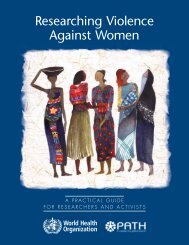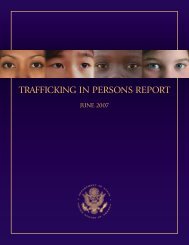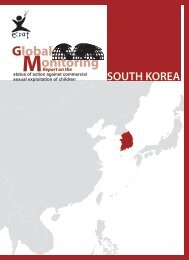Download PDF - Violence Against Children - East Asia and the ...
Download PDF - Violence Against Children - East Asia and the ...
Download PDF - Violence Against Children - East Asia and the ...
Create successful ePaper yourself
Turn your PDF publications into a flip-book with our unique Google optimized e-Paper software.
Vietnam<br />
“States Parties recognise that a mentally or physically<br />
disabled child should enjoy a full <strong>and</strong> decent life, in<br />
conditions which ensure dignity, promote self-reliance<br />
<strong>and</strong> facilitate <strong>the</strong> child’s active participation in <strong>the</strong><br />
community.”<br />
– Article 23.1, Convention on <strong>the</strong> Rights of <strong>the</strong> Child, 1989<br />
“<strong>Children</strong> have traditionally been seen as objects of<br />
charity ra<strong>the</strong>r than subjects of rights. Politicians,<br />
professionals <strong>and</strong> of course parents, have cared for<br />
<strong>the</strong>ir well-being, but primarily in <strong>the</strong> spirit of protecting<br />
<strong>the</strong> vulnerable. It was not widely recognised that<br />
children are also capable, that <strong>the</strong>y have opinions, that<br />
<strong>the</strong>y deserve respect as all o<strong>the</strong>r human beings <strong>and</strong><br />
that <strong>the</strong>y ought to have ‘rights’ .”<br />
– Thomas Hammarberg, Vice-chair, UN Committee on <strong>the</strong> Rights of <strong>the</strong><br />
Child; Ambassador <strong>and</strong> special adviser to <strong>the</strong> Swedish Government on<br />
humanitarian issues, 1996<br />
Useful approaches to<br />
building disabled children’s<br />
participation<br />
The lives of children who have disabilities are<br />
constrained on many levels, <strong>and</strong> clearly, <strong>the</strong><br />
barriers to <strong>the</strong>ir participation in community life<br />
stem not only from <strong>the</strong>ir actual disabilities but<br />
also from o<strong>the</strong>rs’ attitudes to or underst<strong>and</strong>ing<br />
of <strong>the</strong>m. For this reason, programs need to<br />
work with those o<strong>the</strong>rs to ensure <strong>the</strong> inclusion<br />
of people with disability as a priority in social<br />
planning. Approaches found useful include:<br />
1. Provide various training activities to<br />
parents, volunteer CBR workers <strong>and</strong> local<br />
government officers. Approaches need to<br />
vary in style <strong>and</strong> content, <strong>and</strong> include<br />
h<strong>and</strong>s-on study tours. This increases<br />
knowledge <strong>and</strong> awareness, which can<br />
motivate <strong>the</strong>m to be more active in<br />
assisting children with disabilities.<br />
2. Use local (not foreign) trainers where<br />
possible – not only because of <strong>the</strong>ir<br />
underst<strong>and</strong>ing of culture <strong>and</strong> context, but<br />
because <strong>the</strong>ir experience <strong>and</strong> capacity<br />
needs to be recognised <strong>and</strong> to ensure that<br />
learning is applied <strong>and</strong> retained locally.<br />
3. Support <strong>the</strong> involvement of parents.<br />
Parents are often physically <strong>and</strong> mentally<br />
tired from constantly taking care of <strong>the</strong>ir<br />
children, <strong>and</strong> often give up hope that <strong>the</strong>ir<br />
children will improve.<br />
4. Involve volunteers – encourage <strong>the</strong>m to<br />
take leadership roles in <strong>the</strong> community.<br />
We should not just focus on families, as<br />
<strong>the</strong>re is a need to broaden ownership of<br />
issues <strong>and</strong> support available to both <strong>the</strong><br />
family <strong>and</strong> <strong>the</strong> child. The impact for <strong>the</strong><br />
child may be limited if program impacts<br />
stay within <strong>the</strong> family.<br />
5. Local authorities need to gain a good<br />
underst<strong>and</strong>ing of disability, as <strong>the</strong>ir<br />
cooperation on community initiatives is<br />
essential for any work to be done in<br />
Vietnam. Such support enables service<br />
development to take place that is in keeping<br />
with <strong>the</strong> Government’s policy commitments<br />
to children in difficult circumstances.<br />
Grassroots activities (in this case, for <strong>the</strong><br />
rights of children with disabilities) also have<br />
a much better chance when local, city <strong>and</strong><br />
national-level persons are supportive.<br />
6. With limited staff, agencies cannot be<br />
involved with each child. World Vision<br />
Vietnam highlighted what was possible by<br />
working with a few children who had<br />
potential to improve, <strong>the</strong>n sharing <strong>the</strong>se<br />
example/model cases with potential or<br />
actual CBR service providers. In this way,<br />
people can see <strong>the</strong> difference before <strong>and</strong><br />
after <strong>the</strong> intervention, <strong>and</strong> consider some<br />
practical ways of assisting children with<br />
disabilities. This also helps <strong>the</strong>m to see,<br />
not only in <strong>the</strong>ory but in practice, that<br />
conditions for such children can improve<br />
by an effort within <strong>the</strong> community.<br />
Cases – such as that of Huynh Tan Nghia<br />
in <strong>the</strong> text box – are written up <strong>and</strong><br />
(with permission from children <strong>and</strong> <strong>the</strong><br />
family) used as examples. Their stories<br />
<strong>and</strong> photographs are shared in target<br />
communities.<br />
80

















